Dynamics of Melting Process in Phase Change Material Windows Determined Based on Direct Light Transmission
Abstract
:1. Introduction
2. Experimental Methods, Set-up Configuration and Assumptions
2.1. General Assumptions, Material Selection and Prototype Construction
2.2. Experimental Test Stand and Equipement Used in Measurements
2.3. PCM-Glass Sample Construction and Configuration
2.4. Small Scale Set-up, Type of Sensors, Artificial Sun
- -
- LP PYRA 02 pyranometers (Hukseflux, Delft, Netherlands), with a measuring range from 0 to 2000 W/m2;
- -
- T-10 luxmeters (Konica-Minolta, Osaka, Japan) with a measuring range from 0.01 to 299900 lux.
2.5. Refractive Index Measurment Technique
3. Results
3.1. Dynamics of Melting Process
3.2. Direct Light Transmittance during Change of Phase
3.3. Refractive Index
4. Results Interpretation and Discussion
5. Conclusions
Author Contributions
Funding
Institutional Review Board Statement
Informed Consent Statement
Data Availability Statement
Acknowledgments
Conflicts of Interest
References
- Ismail, K.A.R.; Henríquez, J.R. Parametric study on composite and PCM glass systems. Energy Convers. Manag. 2002, 43, 973–993. [Google Scholar] [CrossRef]
- Weinläder, H.; Beck, A.; Fricke, J. PCM-facade-panel for daylighting and room heating. Sol. Energy 2005, 78, 177–186. [Google Scholar] [CrossRef]
- Komerska, A.; Ksionek, D.; Rosinski, M. Determination of the solar transmittance for the translucent shutter with PCM in liquid and solid state. E3S Web Conf. 2017, 22, 84. [Google Scholar] [CrossRef] [Green Version]
- Zhong, K.; Li, S.; Zhou, Y.; Zhang, X. Dynamic heat transfer characteristics of PCM-filled glass window and hollow glass window. Huagong Xuebao/CIESC J. 2014, 65, 114–123. [Google Scholar]
- Lichołai, L.; Musiał, M. Experimental analysis of the function of a window with a phase change heat accumulator. Materials 2020, 13, 3647. [Google Scholar] [CrossRef]
- Hu, Y.; Heiselberg, P.K.; Guo, R. Ventilation cooling/heating performance of a PCM enhanced ventilated window-an experimental study. Energy Build. 2020, 214, 109903. [Google Scholar] [CrossRef]
- Liu, C.; Wu, Y.; Li, D.; Ma, T.; Hussein, A.K.; Zhou, Y. Investigation of thermal and optical performance of a phase change material–filled double-glazing unit. J. Build. Phys. 2018, 42, 99–119. [Google Scholar] [CrossRef]
- Silva, T.; Vicente, R.; Rodrigues, F. Literature review on the use of phase change materials in glazing and shading solutions. Renew. Sustain. Energy Rev. 2016, 53, 515–535. [Google Scholar] [CrossRef]
- Liu, C.; Wu, Y.; Li, D.; Zhou, Y.; Wang, Z.; Liu, X. Effect of PCM thickness and melting temperature on thermal performance of double glazing units. J. Build. Eng. 2017, 11, 87–95. [Google Scholar] [CrossRef] [Green Version]
- Goia, F.; Perino, M.; Serra, V. Experimental analysis of the energy performance of a full-scale PCM glazing prototype. Sol. Energy 2014, 100, 217–233. [Google Scholar] [CrossRef]
- Li, D.; Li, Z.; Zheng, Y.; Liu, C.; Hussein, A.K.; Liu, X. Thermal performance of a PCM-filled double-glazing unit with different thermophysical parameters of PCM. Sol. Energy 2016, 133, 207–220. [Google Scholar] [CrossRef] [Green Version]
- Gowreesunker, B.L.; Stankovic, S.B.; Tassou, S.A.; Kyriacou, P.A. Experimental and numerical investigations of the optical and thermal aspects of a PCM-glazed unit. Energy Build. 2013, 61, 239–249. [Google Scholar] [CrossRef] [Green Version]
- Li, S.; Zou, K.; Sun, G.; Zhang, X. Simulation research on the dynamic thermal performance of a novel triple-glazed window filled with PCM. Sustain. Cities Soc. 2018, 40, 266–273. [Google Scholar] [CrossRef]
- Goia, F.; Bianco, L.; Cascone, Y.; Perino, M.; Serra, V. Experimental analysis of an advanced dynamic glazing prototype integrating PCM and thermotropic layers. Energy Procedia 2014, 48, 1272–1281. [Google Scholar] [CrossRef] [Green Version]
- de Gracia, A.; Navarro, L.; Castell, A.; Cabeza, L.F. Energy performance of a ventilated double skin facade with PCM under different climates. Energy Build. 2015, 91, 37–42. [Google Scholar] [CrossRef] [Green Version]
- Giovannini, L.; Goia, F.; Lo Verso, V.R.M.; Serra, V. A comparative analysis of the visual comfort performance between a PCM glazing and a conventional selective double glazed unit. Sustainability 2018, 10, 3579. [Google Scholar] [CrossRef] [Green Version]
- Vera, S.; Bustamante, W.; Molina, G.; Uribe, D. A flexible and time-efficient schedule-based communication tool for integrated lighting and thermal simulations of spaces with controlled artificial lighting and complex fenestration systems. J. Build. Perform. Simul. 2016, 9, 382–396. [Google Scholar] [CrossRef]
- Al-Masrani, S.M.; Al-Obaidi, K.M. Dynamic shading systems: A review of design parameters, platforms and evaluation strategies. Autom. Constr. 2019, 102, 195–216. [Google Scholar] [CrossRef] [Green Version]
- Silva, T.; Vicente, R.; Amaral, C.; Figueiredo, A. Thermal performance of a window shutter containing PCM: Numerical validation and experimental analysis. Appl. Energy 2016, 179, 64–84. [Google Scholar] [CrossRef]
- Weinlaeder, H.; Koerner, W.; Heidenfelder, M. Monitoring results of an interior sun protection system with integrated latent heat storage. Energy Build. 2011, 43, 2468–2475. [Google Scholar] [CrossRef]
- Bianco, L.; Komerska, A.; Cascone, Y.; Serra, V.; Zinzi, M.; Carnielo, E.; Ksionek, D. Thermal and optical characterisation of dynamic shading systems with PCMs through laboratory experimental measurements. Energy Build. 2018, 163, 92–110. [Google Scholar] [CrossRef]
- Komerska, A.; Bianco, L.; Serra, V.; Fantucci, S.; Rosiński, M. Experimental analysis of an external dynamic solar shading integrating PCMs: First results. Energy Procedia 2015, 78, 3452–3457. [Google Scholar] [CrossRef] [Green Version]
- Heim, D. Phase-Change Material Modeling within Whole Building Dynamic Simulation. ASHRAE Trans. 2006, 112, 518–525. [Google Scholar]
- Tabares-Velasco, P.C.; Christensen, C.; Bianchi, M. Verification and validation of EnergyPlus phase change material model for opaque wall assemblies. Build. Environ. 2012, 54, 186–196. [Google Scholar] [CrossRef]
- Wijesuriya, S.; Tabares-Velasco, P.C.; Biswas, K.; Heim, D. Empirical validation and comparison of PCM modeling algorithms commonly used in building energy and hygrothermal software. Build. Environ. 2020, 173, 106750. [Google Scholar] [CrossRef]
- Wieprzkowicz, A.; Heim, D. Modelling of thermal processes in a glazing structure with temperature dependent optical properties-An example of PCM-window. Renew. Energy 2020, 160, 653–662. [Google Scholar] [CrossRef]
- Dellicompagni, P.; Franco, J.; Heim, D.; Wieprzkowicz, A. Numerical modeling of phase change materials using simusol software. Appl. Therm. Eng. 2020, 170, 114772. [Google Scholar] [CrossRef]
- Giovannini, L.; Goia, F.; Lo Verso, V.R.M.; Serra, V. Phase Change Materials in Glazing: Implications on Light Distribution and Visual Comfort. Preliminary Results. Energy Procedia 2017, 111, 357–366. [Google Scholar] [CrossRef] [Green Version]
- Zhao, D.; Zhang, G.; Zhang, X.; Li, D. Optical properties of paraffin at temperature range from 40 to 80 °C. Optik 2018, 157, 184–189. [Google Scholar] [CrossRef] [Green Version]
- Li, D.; Zheng, Y.; Li, Z.; Qi, H. Optical properties of a liquid paraffin-filled double glazing unit. Energy Build. 2015, 108, 381–386. [Google Scholar] [CrossRef]
- Goia, F.; Zinzi, M.; Carnielo, E.; Serra, V. Spectral and angular solar properties of a PCM-filled double glazing unit. Energy Build. 2015, 87, 302–312. [Google Scholar] [CrossRef] [Green Version]
- Lechowska, A.A.; Schnotale, J.A. Thermal transmittance of multi-layer glazing with ultrathin internal partitions. In Proceedings of the BS2015: 14th Conference of International Building Performance Simulation Association, Hyderabad, India, 7–9 December 2015; pp. 2134–2141. [Google Scholar]
- Kulakowski, T.; Heim, D. Modeling of thermal and optical processes in translucent structures filled with PCM layer using moving mushy volume approach. In Proceedings of the 16th IBPSA Conference Rome, Rome, Italy, 2–4 September 2019; pp. 1459–1466. [Google Scholar]
- Rheims, J.; Köser, J.; Wriedt, T. Refractive-index measurements in the near-{IR} using an Abbe refractometer. Meas. Sci. Technol. 1997, 8, 601–605. [Google Scholar] [CrossRef]
- Chemical, I. Crystallographical and Physical Properties of Liquid Paraffins and Paraffin Waxes. In Paraffin Products; Freund, M., Csikós, R., Keszthelyi, S., Mózes, G.Y., Eds.; Developments in Petroleum Science; Elsevier: Amsterdam, The Netherlands, 1982; Volume 14, pp. 13–140. [Google Scholar]
- Davies, M.M.; Dudley, R.J.; Smalldon, K.W. An investigation of bulk and surface refractive indices for flat window glasses, patterned window glasses and windscreen glasses. Forensic Sci. Int. 1980, 16, 125–137. [Google Scholar] [CrossRef]

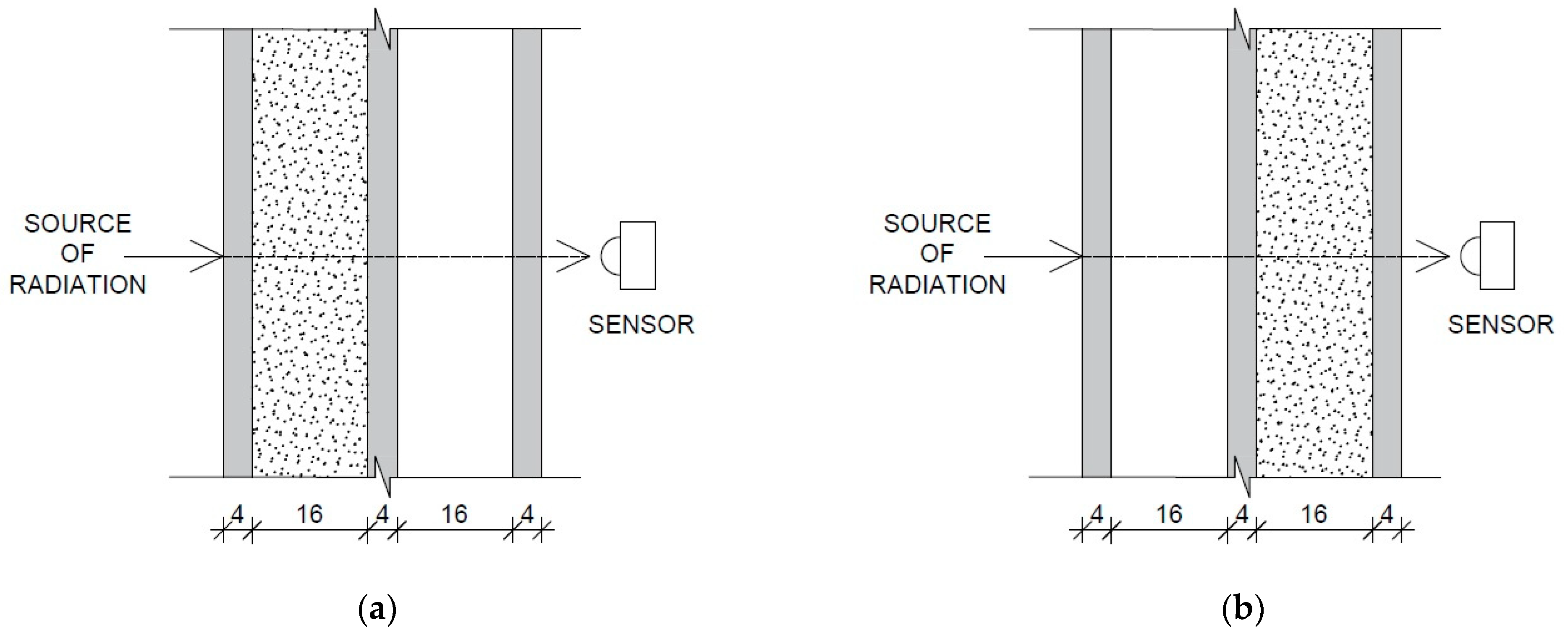


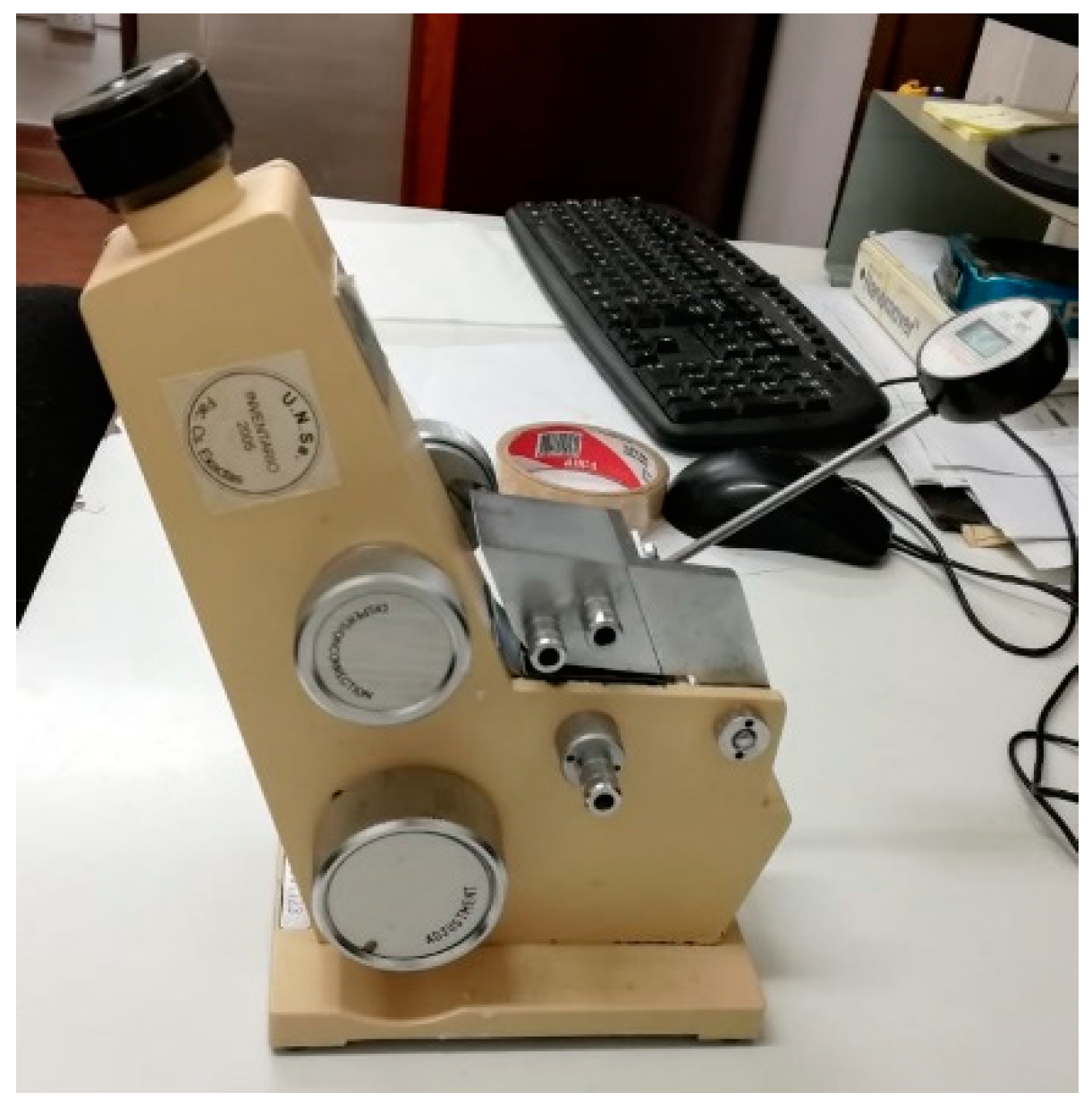
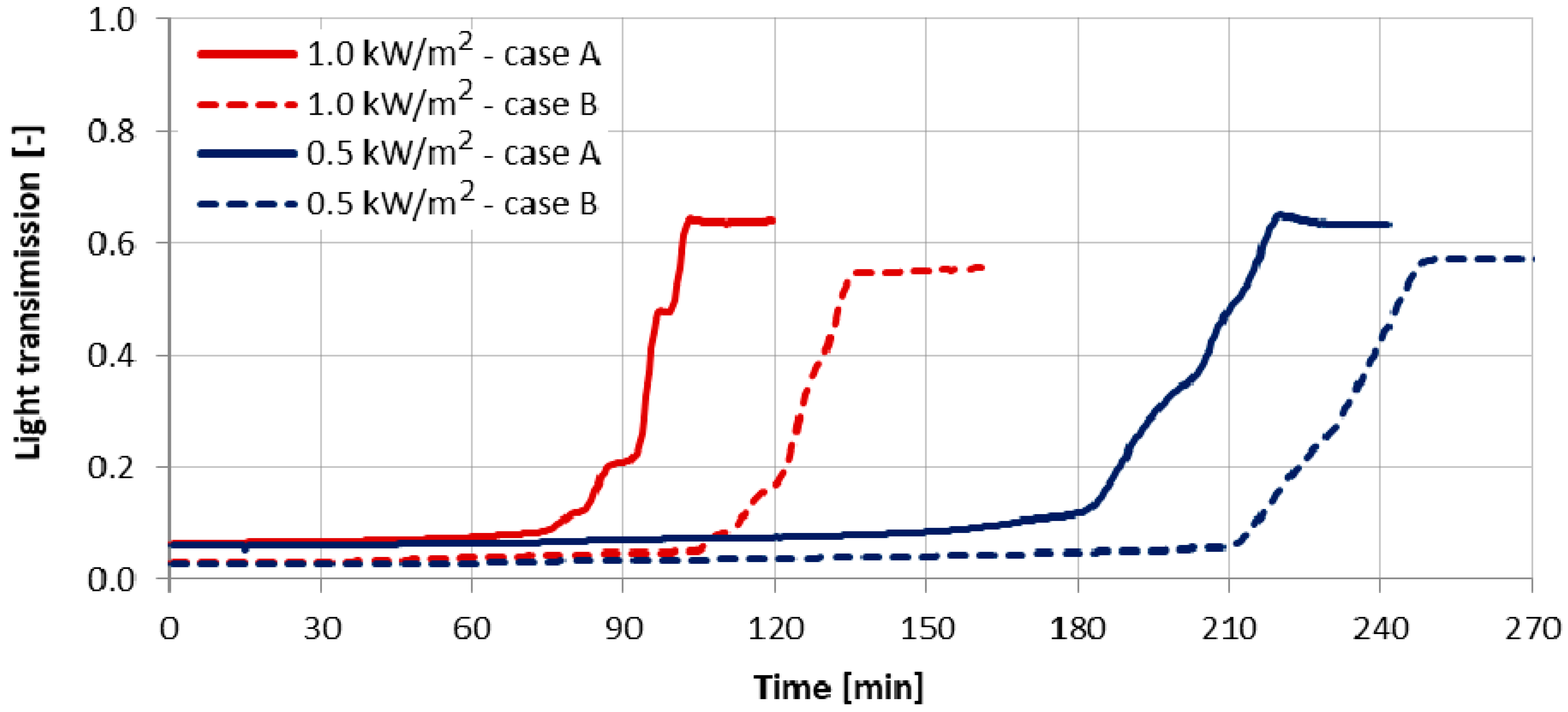


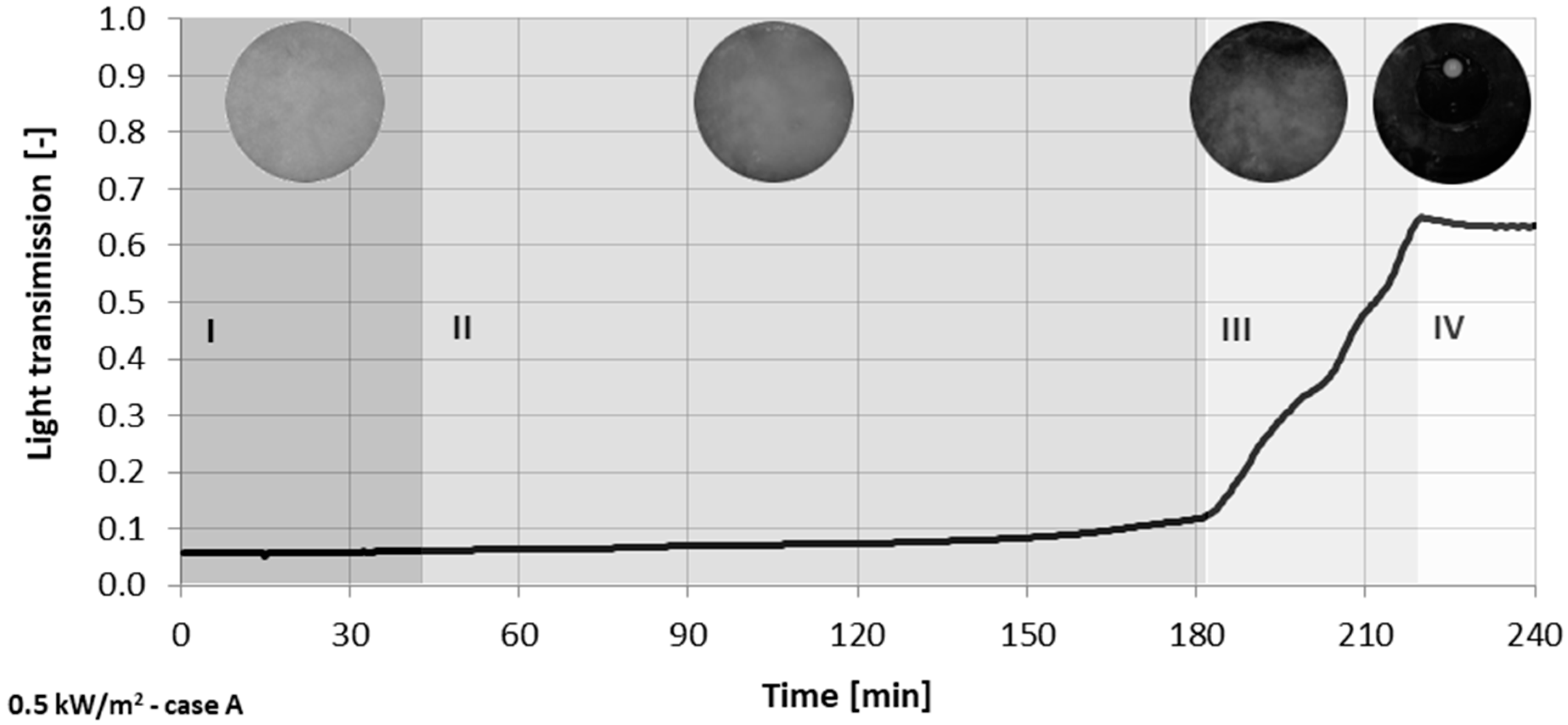
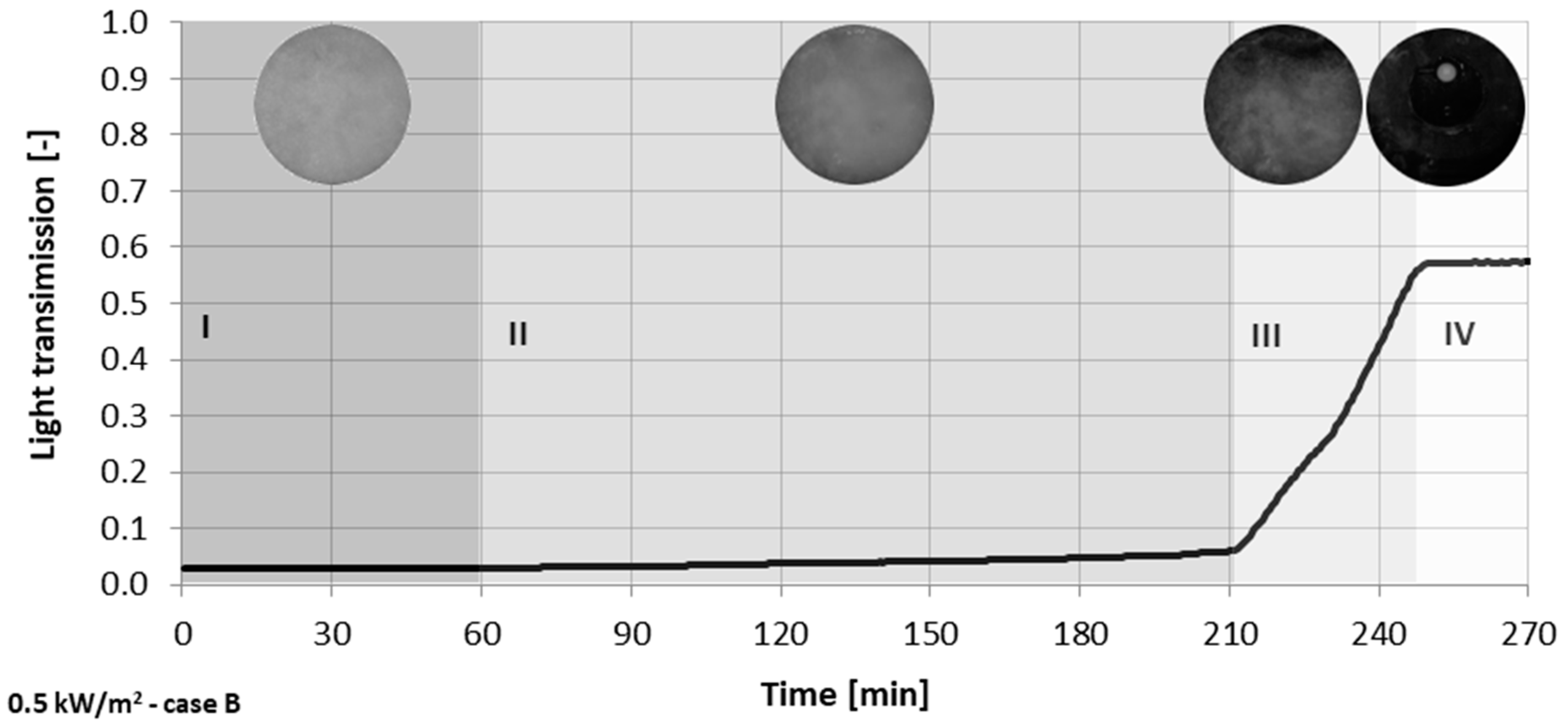
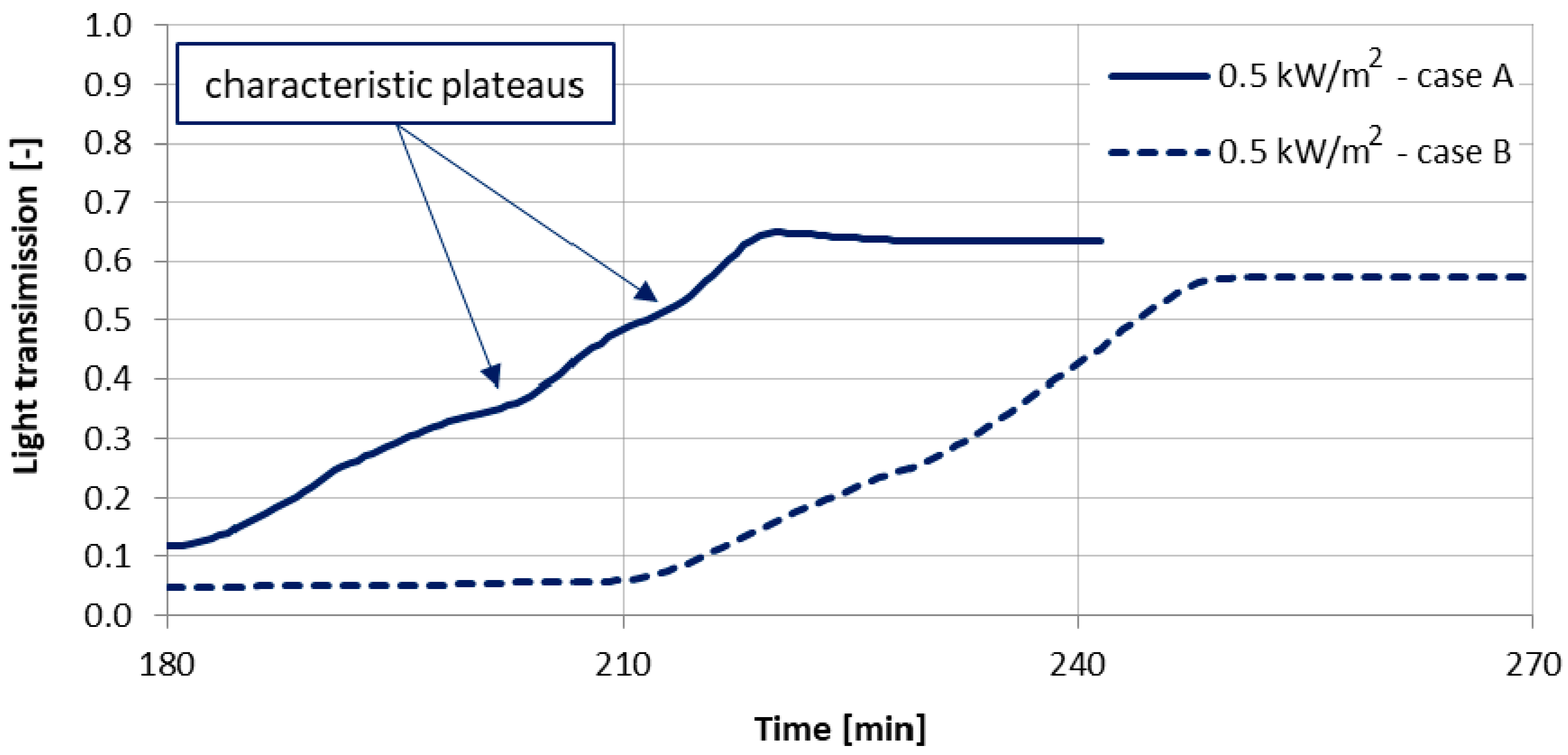



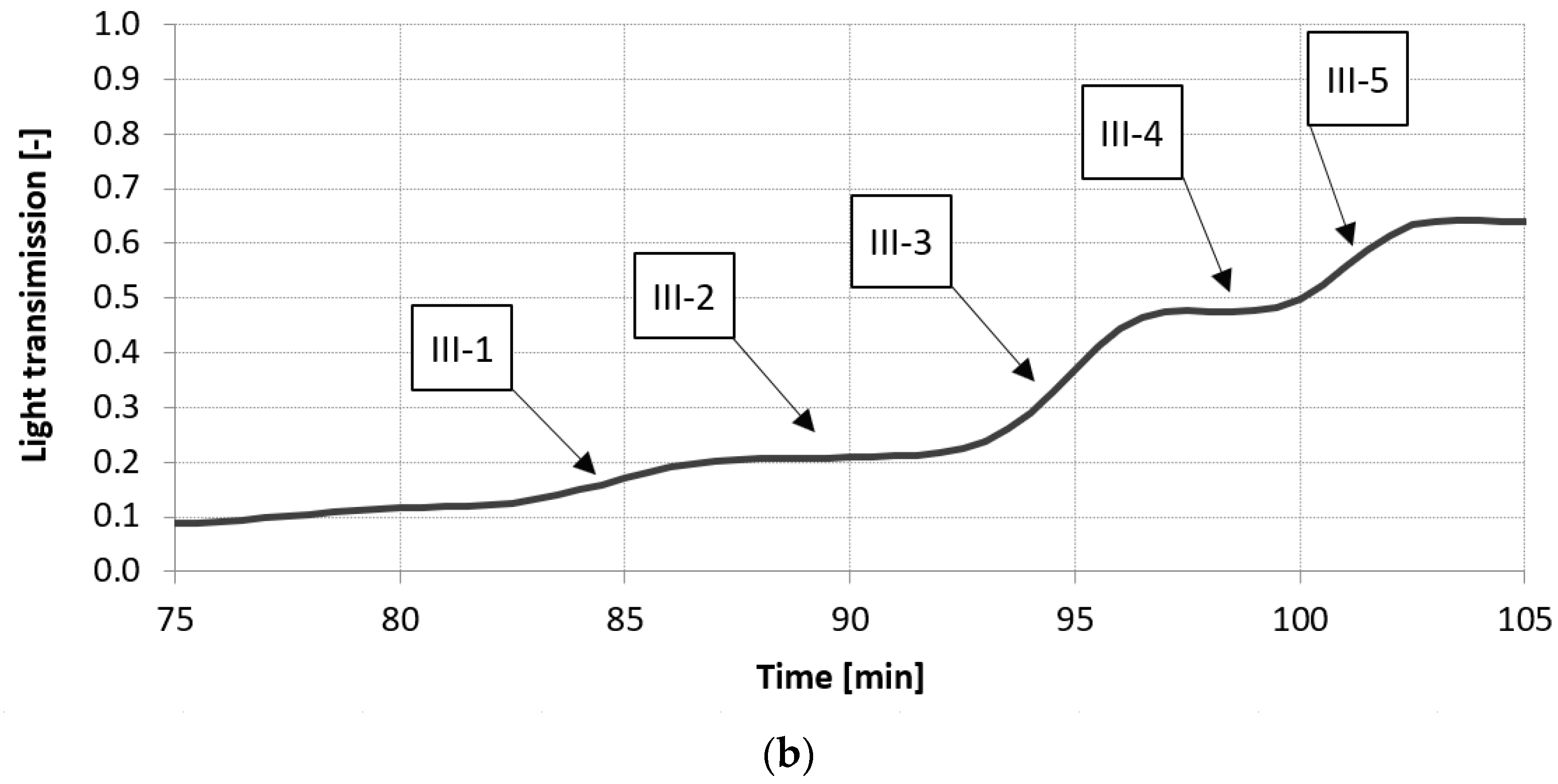

Publisher’s Note: MDPI stays neutral with regard to jurisdictional claims in published maps and institutional affiliations. |
© 2021 by the authors. Licensee MDPI, Basel, Switzerland. This article is an open access article distributed under the terms and conditions of the Creative Commons Attribution (CC BY) license (http://creativecommons.org/licenses/by/4.0/).
Share and Cite
Heim, D.; Krempski-Smejda, M.; Dellicompagni, P.R.; Knera, D.; Wieprzkowicz, A.; Franco, J. Dynamics of Melting Process in Phase Change Material Windows Determined Based on Direct Light Transmission. Energies 2021, 14, 721. https://doi.org/10.3390/en14030721
Heim D, Krempski-Smejda M, Dellicompagni PR, Knera D, Wieprzkowicz A, Franco J. Dynamics of Melting Process in Phase Change Material Windows Determined Based on Direct Light Transmission. Energies. 2021; 14(3):721. https://doi.org/10.3390/en14030721
Chicago/Turabian StyleHeim, Dariusz, Michał Krempski-Smejda, Pablo Roberto Dellicompagni, Dominika Knera, Anna Wieprzkowicz, and Judith Franco. 2021. "Dynamics of Melting Process in Phase Change Material Windows Determined Based on Direct Light Transmission" Energies 14, no. 3: 721. https://doi.org/10.3390/en14030721




